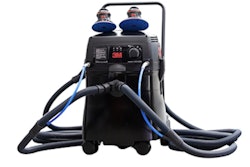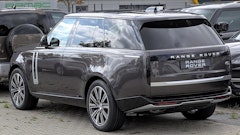| The new body panel concept uses an outer skin of glass fibre mats impregnated with thermoplastic. |
Pittsburgh, Pennsylvania — December 6, 2013 — A new concept from Bayer MaterialScience is treading new ground in the development of automotive parts with a sandwich structure. Bayer MaterialScience showcased a sample trunk lid at the K 2013 International Plastics and Rubber Trade Fair in Düsseldorf, Germany, that was constructed of an outer layer made of glass fibres and thermoplastic polymer, and an inner layer of polyurethane foam.
Bayer MaterialScience says the design was was modeled on nature in two different ways.
“With its smooth, dense outer skin and foamed core, this part has a lot in common with a bone,†says Ulrich Grosser, team leader for advanced technologies at Bayer MaterialScience. “To make the outer layer, continuous glass fibre mats are impregnated with a thermoplastic polymer formulated from polycarbonate. All the fibres are wetted and fully coated by the plastic matrix. This is the key to the high stiffness of the edge layers in a sandwich structure.â€
Polycarbonate blends shrink only very minimally, and the process results in a very smooth, high-quality surface. It can subsequently be coated to achieve the desired appearance.
In a second step, the top and bottom of the trunk lid are joined and the resulting hollow space is filled with a Baysafe polyurethane foam. It is the very low density of the foam that makes the component so lightweight.
The foam is also very stiff, and adheres to the entire outer surface, which means the component is extremely resistant to minor damage. In the event of a collision, the foam absorbs energy, enhancing the safety of passengers and pedestrians.
Antennas can be embedded in the foam very efficiently and permanently. Unlike metal components, polymers permit undisrupted reception across a wide frequency range. Additional functions, up to and including lighting, can be integrated into the sandwich component.
To promote the realistic use of the concept part in a vehicle, the company also developed an intelligent solution for mounting it to the rear of the vehicle.
“Nature once again proved to be the best master builder in this case,†says Grosser. The task was to devise a robust and lasting connection between the hinge and the lightweight structure of the trunk lid. “To find a solution, we studied how trees are anchored to the forest floor. A network of roots lends even tall and heavy trees a secure hold in soil that frequently is soft.â€
For a realistic solution, the Bayer researchers optimized the look of the hinge mount using computer-aided engineering (CAE). The resulting plastic structure looks remarkably like the roots of a tree in the ground. Tests confirm that the hinge mount can be attached easily and holds very firmly in the lightweight foam core.
“We passed a milestone in the efficient production of sandwich components with this material-based design,†says Dr. Olaf Zöllner, head of application technology for polycarbonate, summarizing previous developments. Zöllner sees this body part as just one example of the numerous possibilities of the new technology.
“Such lightweight and stiff composites made from polycarbonate blends are excellently suited to the fabrication of ultrabooks and other high-tech products, for example,†says Zöllner. “The auto industry often leads the way in pioneering technical developments, but we are also looking forward to talks with customers and partners in other industries.â€



















